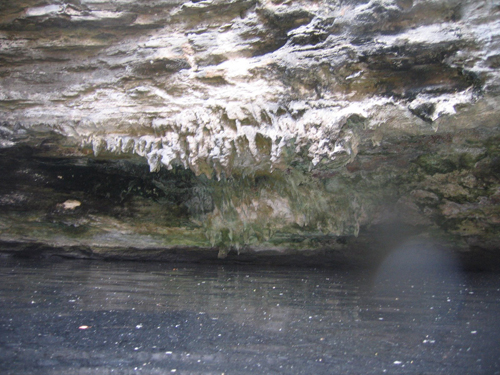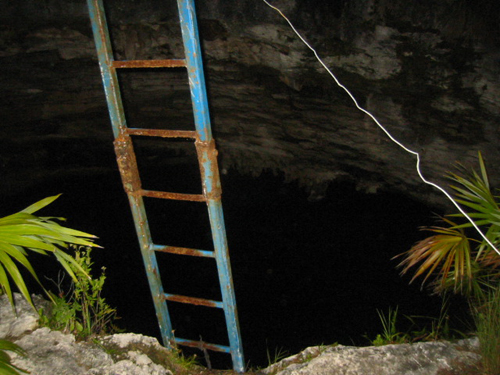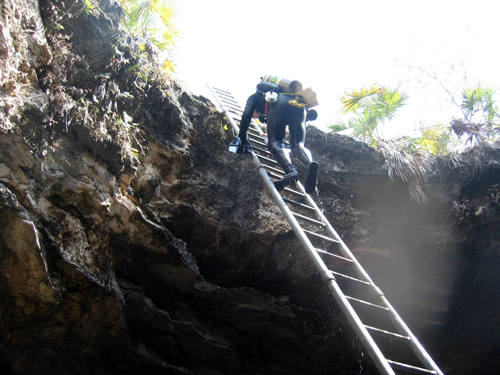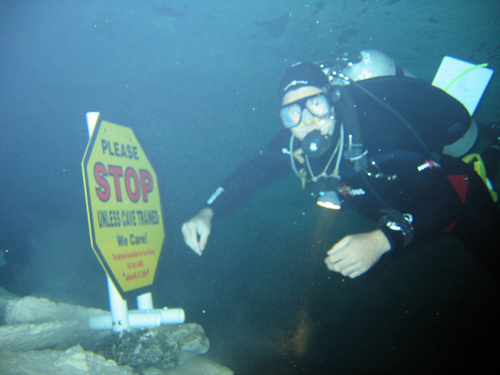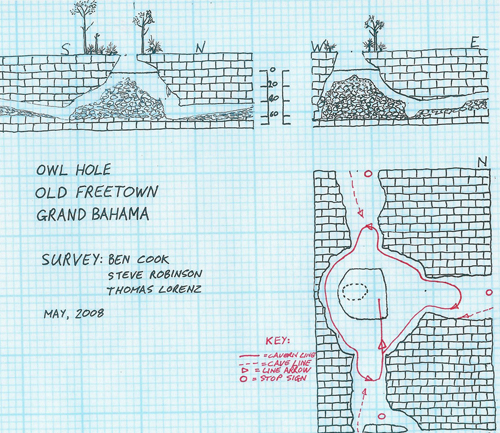From:TheBahamasWeekly.com
The Owl Hole Project
By Ben Cook
Jun 3, 2008 - 11:38:50 PM
Editor's Note: The following article was written for the Journal of the National Association for Cave Diving and was reprinted with permission.
Owl Hole is the larger of the two cave entrances that make up the Old Freetown system on Grand Bahama Island. It is a textbook quality example of a limestone sinkhole, formed by the collapse of a section of a cavern’s roof. Entry via Owl Hole cuts almost 3000ft off the swim to access the cave passage to the north, which extends for an additional 2000ft with the possibility of further discoveries enlarging the known cave still further. The cave lies on land owned by the Grand Bahama Port Authority, which has been content to leave access largely unregulated for many years now.
In 2004 it came to my attention that Owl Hole would benefit from a little work to help conserve the cave environment as well as improve access and diver safety, while introducing a system of cavern lines and signage which would bring the cavern zone towards what international divers could expect to find in other parts of the world.
We set ourselves certain targets, including:
• Removing and replacing the existing ladder.
• Removing an old truck battery and other refuse.
• Installation of a permanent cavern line.
• Marking the limits of the cavern zone with stop signs.
• Producing a diagram of the cavern zone.
The team was made up of a mix of cave divers working and living on the island, visiting cave divers, family members, and passers-by. Everyone involved volunteered their time, and several members contributed financially for various pieces of hardware. The NACD generously donated the gold line and the stop signs.
Removing and replacing the ladder.
The drop into the water is 24 feet long, we calculated that an approximately 40 feet long ladder would do the job …… this became urgently important when one of our divers fell through the old ladder, luckily catching himself on the rung below. Steve Robinson demonstrated his grasp of winch and pulley theory to both remove and replace these ladders. The new ladder is made from 3 inch diameter marine grade steel tubing, welded together by Steve and his volunteers. We all hope it’ll outlast us as it weighs a ton!
Clean-Up
On almost every dive we would remove a bag full of old tin cans and beer bottles, until we felt the cave was clear of such refuse. I need to thank an anonymous transportation driver from the Pirates of the Caribbean movie who helped haul the truck battery out of the hole.
Installation of Permanent Cavern Line
Johny Chessa, an NACD cave diver and open water instructor, and I spent almost three hours installing the guideline. It follows the perimeter of the cavern entering a short distance into each of the three cave tunnels. The presence of a halocline and especially the amount of percolation that occurs in certain sections make the cavern guideline especially beneficial.
Installation of Stop Signs
Thomas Lorenz, of Xanadu Undersea Adventures and an NACD cave diver, generously donated his tools, van, and time to help with the installation of the stop signs. We used stainless steel hardware to bolt the signs to PVC plumbing pipe, which was in turn bolted onto rocks of the local limestone. We aimed to use materials naturally occurring in the cavern where possible. Each sign is located approximately 150ft from open water at the start of the three cave tunnels.
Producing a diagram of the Cavern Zone
Steve Robinson, Kevin Jones, and Thomas Lorenz have all helped collect the data for our survey of Owl Hole. We hope that the diagram will assist cavern divers in planning safer cavern dives, as well as show what a natural wonder exists here – a wonder that many people on the island are unaware of.
Diving Owl Hole
Although it would be possible to dive Owl Hole as an open water dive, the near certainty of inadvertently passing into the ‘overhead’ environment strongly recommends cavern or cave training. A cavern dive can be safely enjoyed by open water certified divers only in the company of a properly trained and equipped cavern guide.
To cave dive here, the diver should be properly trained and equipped for cave diving, and like always must not exceed their level of training.
Cavern
The permanent cavern line will help to safely explore the cavern zone. Take note of the ceiling where you can see large areas of fossilized star corals and various shells. The halocline occurs around 35ft and creates some great effects. While ascending watch the walls for some impressive collections of stalactites. Wonderful views back up to the surface and light displays throughout. Watch out for crayfish, freshwater eels and two other species of freshwater fish.
Try and plan to dive in one direction as percolation from the ceiling can rapidly reduce visibility. Be aware of the effects of the halocline on visibility also.
Cave
The north and south sections from Owl Hole offer some wonderful cave diving. To the south the traverse to Mermaid’s Lair is a possibility through 2900ft of highly decorated passage at an average depth of 70ft. The ‘Big Room’, surprisingly, is a big room approx. 80ft in diameter, and 40ft from floor to ceiling.
To the north it is possible to enter a short, deep section where the cave descends to over 100ft. allowing the development of stalagmites over 20ft tall. Many passages are highly decorated and display interesting sedimentation. It is possible to see blind cave-fish, remipedia and isopods throughout.
Bring plenty of clothes-pins as there are 65 T’s in the line. The average cave tunnel is from 4-6ft from floor to ceiling, the floor is covered with extremely fine sediment (as this is a virtually no flow system) and the decorations are extremely fragile. Therefore mastery of buoyancy control is an absolute requirement, for the cave’s sake as well as your own.
The Future
There are persistent rumours that the land above the Old Freetown system is about to be turned into a golf resort complex. We hope to complete a modern, accurate map of the system to help any future developers to minimize their impact on the system, we will try to negotiate continued access to the site and let the people of the Bahamas know that they have something which is very much worth protecting.
Team Members:
Ben Cook William Fogo
Steve Robinson Johny Chessa
Thomas Lorenz David O’Dell
Kevin Jones Sam Rutherford
Mark Colangelo David Cook
The Author: Ben Cook is the NACD Safety Officer for the Bahamas, and an NACD cave diving instructor. He lives in Orlando, Florida, and organizes and leads cave diving trips to the Bahamas, Florida and Mexico. For any information or advice on cave or cavern diving on Grand Bahama, he can be contacted at
BahamaBenCook@Hotmail.com
.
Bahama Ben's Blog HERE
© Copyright 2008 by thebahamasweekly.com -
